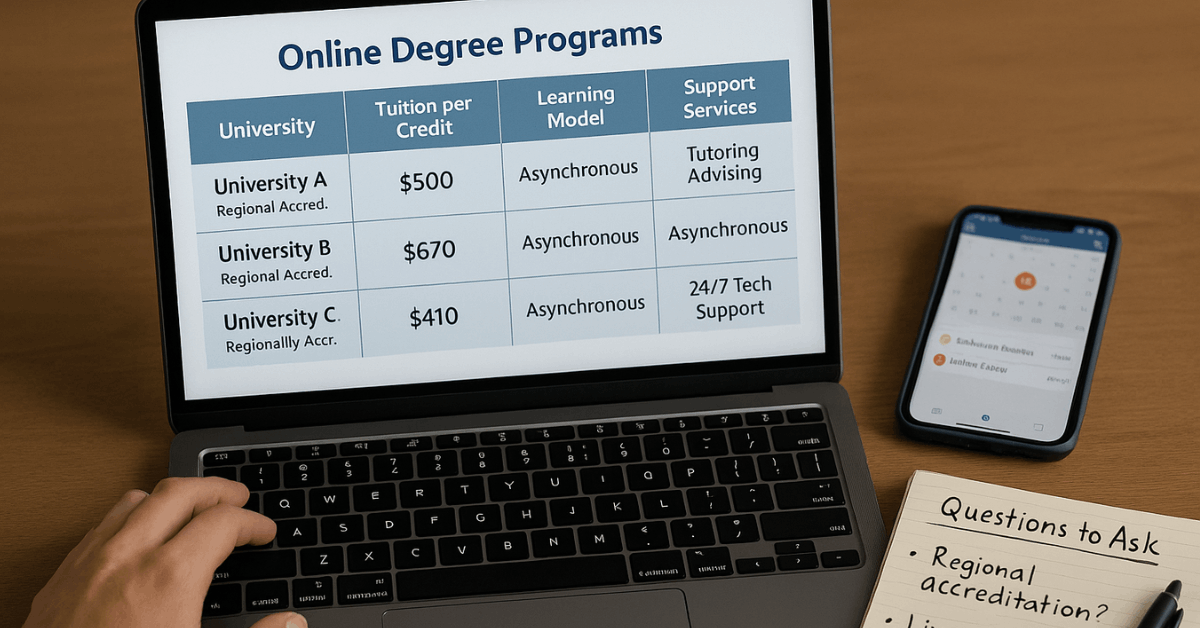Online study is no longer a fringe alternative; it is the default path for countless professionals who refuse to pause their careers while earning new credentials worldwide.
This guide equips you with every key fact, no fluff, no jargon, so you can choose, finance, and finish a reputable online degree that moves your career forward.
Why Working Professionals Gravitate to Online Degrees Now
Flexibility remains the primary draw. Cloud-based classrooms let you stream lectures after a late shift, post discussion replies during lunch, and submit projects from airports.

Meanwhile, broadband penetration and smoother learning platforms have erased most technical headaches. Employers also endorse online credentials because top universities deliver the same curriculum and confer identical diplomas for on-campus and distance cohorts.
Employment data underscores the payoff: adults aged 25-34 who hold at least a bachelor’s enjoy an 87 percent employment rate worldwide, versus 73 percent for those whose education stopped at secondary school.
Advantages and Drawbacks
Online formats remove location barriers, therefore you gain far wider program options and can study without leaving a paycheck behind.
Virtual learning demands discipline, which means self-motivation and time-blocking skills become non-negotiable.
Pros:
- Attend classes anywhere an internet connection exists.
- Enroll in highly ranked programs outside your region without relocation costs.
- Build a study calendar that wraps around shift work and family care.
Cons:
- Self-paced modules test focus and delay tolerance.
- Live interaction with instructors shifts to video or chat, not hallways.
- Networking requires extra effort through forums, LinkedIn™, or virtual meetups.
Five Criteria Every Applicant Must Verify
Missing a single factor below can derail your investment; as a result, vet each point before paying any application fee.
- Accreditation Status – Confirm regional or internationally recognized accreditation so employers and other universities respect the credential.
- Curriculum Quality – Compare online syllabi with on-campus counterparts to ensure parity.
- Learning Format – Decide between synchronous, asynchronous, fixed-time, open-schedule, or hybrid models that match your routine.
- Student Support – Look for remote tutoring, library access, career services, and 24 × 7 tech help.
- Total Cost of Attendance – Add tuition, platform fees, books, and potential residency travel to reveal the real price tag.
Online Learning Models Explained
Burned by rigid timetables in the past? Consider these formats; that way you can align study rhythm with life realities.
| Model | Key Features | Best For |
| Synchronous | Live video sessions at set times; mandatory attendance. | Learners who thrive on real-time discussion and accountability. |
| Asynchronous | Recorded lectures and forums with weekly deadlines. | Professionals juggling unpredictable shifts. |
| Open-Schedule | Self-paced start dates and finish targets. | Contractors or travelers needing maximum freedom. |
| Fixed-Time | Entirely online but requires logging in at specified hours. | Students wanting structure without campus trips. |
| Hybrid | Mix of online coursework and occasional campus labs or residencies. | Majors requiring hands-on components such as nursing or engineering labs. |
Ten Leading Global Online Universities
Global bodies increasingly benchmark online quality; as a result, the institutions below scored highest on engagement, technology, faculty, and support.
| Rank | University | Tuition USD / Credit | Application Window | Financial Aid |
| 1 | University at Buffalo — SUNY | 353 | Rolling | Yes |
| 2 | University of Florida | 500 | Rolling | Yes |
| 3 | University of Illinois Chicago | 346 | Rolling | Yes |
| 3 | University of North Carolina-Charlotte | 318 | July 1 | Yes |
| 5 | The Ohio State University | 493 | Rolling | Yes |
| 6 | CUNY School of Professional Studies | 350 | Rolling | Yes |
| 7 | Arizona State University | 574 | Rolling | Yes |
| 7 | Oregon State University | 366 | Rolling | Yes |
| 9 | University of Central Florida | 716 | Rolling | Yes |
| 10 | Colorado State University — Global | 375 | Rolling | Yes |
All universities accept qualified applicants worldwide, subject to local visa or residency rules.
Funding Your Degree: Five Essential Moves
Sticker shock sinks many ambitions; in turn, mastering these steps protects your budget.
- Submit the FAFSA or Local Equivalent Early – Priority deadlines unlock larger grant pools.
- Apply for Institutional and External Scholarships – Target awards earmarked for adult or online learners.
- Review the Student Aid Report Carefully – Correct errors fast to prevent processing delays.
- Compare Aid Packages Side by Side – Focus on net cost after grants, not headline tuition.
- Renew Aid Annually – Keep paperwork current so funds keep flowing until graduation.

Application Roadmap in Six Clear Steps
An orderly checklist prevents last-minute scrambles; as a result, admissions officers receive complete, polished files.
- Complete the Common Application or program-specific form.
- Craft essays that link professional experience to academic goals.
- Secure recommendation letters from supervisors or instructors who know your work ethic.
- Verify testing rules—submit SAT, ACT, GRE, or GMAT only if required.
- Upload official transcripts and document prior credits for transfer evaluation.
- Track every deadline for admission, aid, and test score submission in a shared calendar.
Spotting and Avoiding Diploma Mills
Promises of overnight degrees signal danger; therefore, walk away if any signs below appear.
- No recognized accreditation listed or vague claims without agency names.
- Flat-fee pricing that ignores credit hours.
- Unrealistic completion timelines such as “Bachelor’s in six weeks.”
- No physical address, only a post-office box or generic contact form.
- Numerous spelling errors on the website or lack of “.edu” domain.
For-Profit vs Non-Profit Institutions: Key Differences
Confused by corporate versus traditional models? The contrast below clarifies implications for cost and credibility.
| Aspect | For-Profit Online Colleges | Non-Profit Universities |
| Mission Focus | Investor returns alongside education. | Student learning and institutional reinvestment. |
| Accreditation Trend | Predominantly national accreditation. | Predominantly regional accreditation. |
| Admissions Selectivity | Generally open or rolling. | Often competitive with prerequisite standards. |
| Support Services | Improving, yet may vary widely. | Typically robust and campus-integrated. |
| Perception Among Employers | Improving but still mixed. | Consistently positive when regionally accredited. |
Maximizing Value and Speed
Need to graduate sooner or cheaper? Strategic choices can shrink timelines and invoices, which means you retain cash and career momentum.
- Transfer Existing Credits – Confirm acceptance policies early to avoid lost coursework.
- Select Competency-Based or Accelerated Tracks – Demonstrate knowledge quickly and move ahead.
- Leverage Employer Tuition Assistance – Many companies reimburse up to full tuition for approved programs.
- Bundle Certificates with the Degree – Stackable micro-credentials add résumé shine before graduation.
High-Demand Degrees and Salary Outlook
Earning potential influences many decisions; that way, you align passion with payoff.
| Field | Typical Online Degree | Early-Career Median (USD) |
| Petroleum Engineering | Bachelor of Science in Engineering | 142,800 |
| Information Technology Management | Master of Science in IT Management | 173,670 |
| Marketing Management | Bachelor or MBA | 158,280 |
| Financial Management | MBA or Master of Finance | 166,050 |
| Nursing Practice (NP) | Master of Science in Nursing | 120,680 |
Beyond these headline figures, data analysts, cybersecurity specialists, and healthcare administrators continue to post double-digit growth rates worldwide.
Frequently Asked Questions
Common questions answered:
- How much does an online bachelor’s cost?
Tuition ranges broadly—from under USD 120 per credit at public institutions for residents to over USD 700 at renowned research universities—yet online learners avoid housing and commuting expenses and often pay equal in-state rates worldwide. - How long will the degree take?
Standard completion remains four years, yet part-time pacing, credit transfers, and accelerated calendars can shorten or extend that timeline. - Are employers skeptical of online learning?
Reputable accreditation neutralizes past bias. Most hiring managers value skill mastery and university stature over delivery mode. - Which majors suit a remote work lifestyle?
Software engineering, data science, digital marketing, and project management translate smoothly to home offices. - Is there a free accredited option?
University of the People offers tuition-free degrees worldwide, charging only modest assessment fees, provided the open-source model suits your learning style.
Conclusion
Earning an online degree in 2025 demands discipline, research, and smart financing, yet the payoff can reshape your career trajectory without uprooting your life.
Lock in accreditation, choose a format that fits, secure funding early, and commit to consistent study blocks. Do that, and your diploma will arrive before you know it—ready to unlock new professional doors around the globe.










